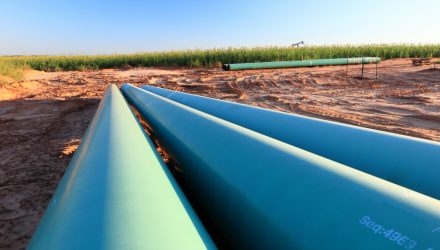While most investors allocate to midstream for its generous income or total return, many are unaware how the segment is positioned to capture opportunities emerging from the energy transition.
Midstream tends to be a longer-term investment in most portfolios, making it essential for investors to understand how the increasing opportunity for clean energy intersects with midstream.
Energy infrastructure assets are ultimately assets used to transfer molecules, to process molecules, and to store molecules. While historically those molecules have been crude oil and natural gas, in the future, those molecules will be defined by clean energy sources like hydrogen, renewable fuels, and carbon dioxide, Paul Baiocchi, chief ETF strategist at SS&C ALPS Advisors, said during a VettaFi LiveCast on November 17.
Carbon capture in particular is a compelling area for midstream’s involvement. Big names in energy like Chevron, Exxon, and Shell have been partnering with midstream companies to look at opportunities in carbon capture, and these opportunities are increasingly viable due to the Inflation Reduction Act, which increased the 45Q credits and also included a direct pay option.
“For midstream, I think carbon capture is interesting because there’s existing expertise around this and the ability to use existing assets,” Stacey Morris, head of energy research at VettaFi, said during the LiveCast. “For example, Kinder Morgan has the largest transportation capacity for carbon dioxide in North America, so this is something that names like Kinder Morgan are clearly comfortable with.”
Morris also flagged EnLink Midstream, a smaller midstream name, which recently announced that it signed a transportation services agreement with Exxon to transport carbon dioxide. EnLink has previously discussed the opportunity for using existing natural gas pipelines to transport captured carbon dioxide.
“These are things that can be done in the next couple years, this isn’t something that’s two decades away,” Morris said.
Credits included in the Inflation Reduction Act are also going to be helpful for getting more traction in hydrogen production.
“Going forward, this is something that can be blended maybe around 5–10% into existing natural gas streams and move through existing natural gas infrastructure,” Morris said. “So there’s a lot of opportunity here in the future, a little bit of application today, but midstream companies are positioning for this.”
Similar to the transportation and storage hubs for oil and natural gas, there will need to be hubs for hydrogen. Morris cited Williams as an example, which is looking at a hydrogen hub in Wyoming. Williams also has a corporate venture capital arm that recently made a direct investment in a small hydrogen producer.
Midstream companies are also positioning themselves for opportunities around renewable diesel and natural gas, as well as sustainable aviation fuel. Morris said Kinder Morgan has been the standout in renewable natural gas, having acquired several small RNG producers.
“Recently, we saw TC Energy, a Canadian C-corp, announce that they were going to partner in a renewable natural gas facility on site at the Jack Daniel Distillery in Tennessee,” Morris said. “They’ll be marketing renewable natural gas from that facility and also the renewable credits that come with the production of that renewable natural gas.”
“I think this shows that the energy evolution is not necessarily straightforward. It’s not necessarily what you think it’s going to be, and there are a lot of opportunities that are maybe outside the box, like producing RNG from a distillery,” Morris added.
SS&C ALPS has two strategies that offer investors exposure to the energy infrastructure space: the Alerian MLP ETF (AMLP), which offers exposure to MLPs that operate in the energy infrastructure space, and the Alerian Energy Infrastructure ETF (ENFR), which provides exposure to the energy infrastructure space but broadens the universe to include both C-corps and MLPs.
ENFR has a greater focus on total return, whereas AMLP has a greater focus on yield — between 80–85% of AMLP’s distributions historically have been considered a tax-deferred return of capital. Notably, over 33% of the underlying index for ENFR, by weighting, has a net-zero emissions target.
For more news, information, and strategy, visit the Energy Infrastructure Channel.
vettafi.com is owned by VettaFi, which also owns the index provider for ENFR and AMLP. VettaFi is not the sponsor of ENFR and AMLP, but VettaFi’s affiliate receives an index licensing fee from the ETF sponsor.

